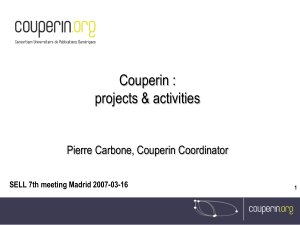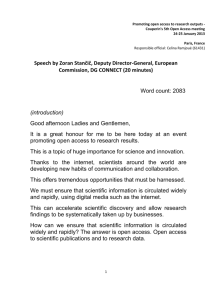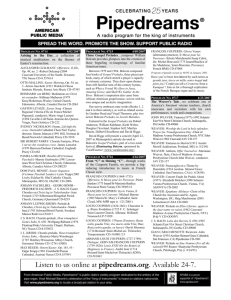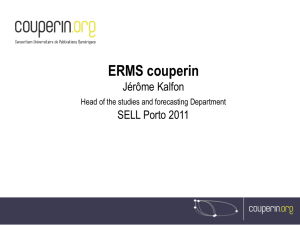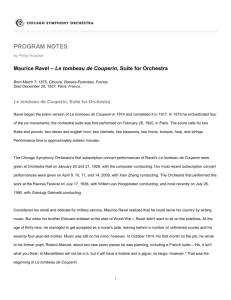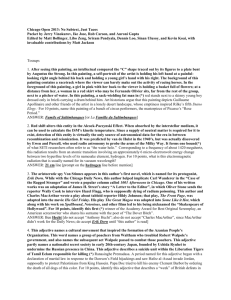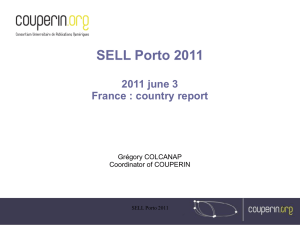History Research Paper
advertisement
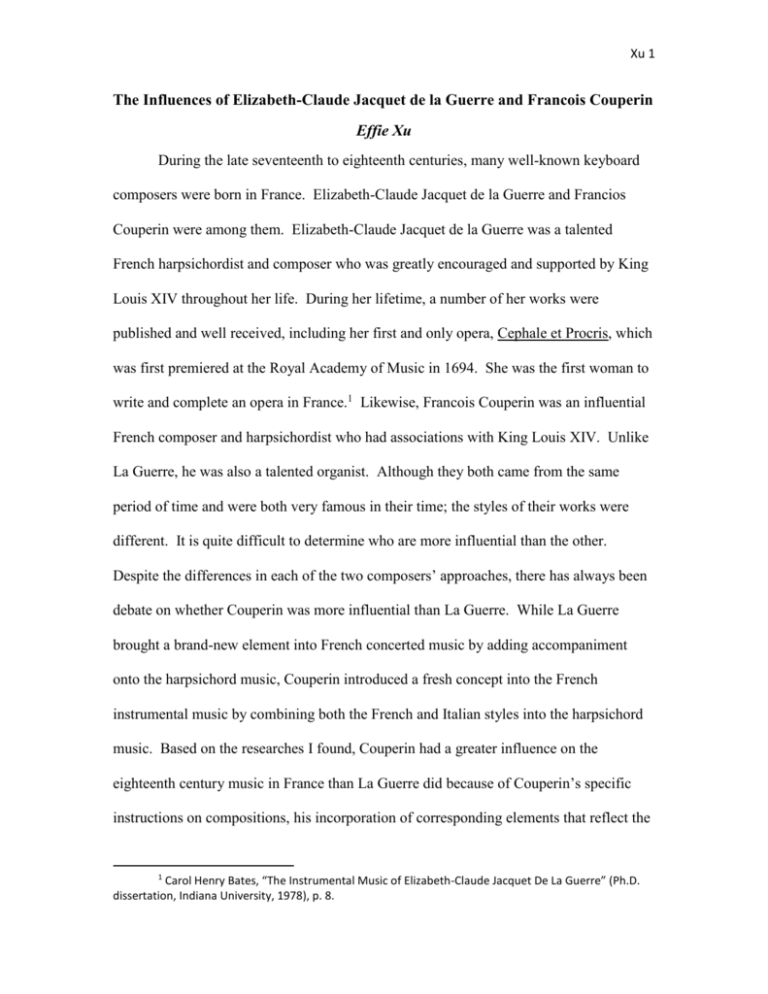
Xu 1 The Influences of Elizabeth-Claude Jacquet de la Guerre and Francois Couperin Effie Xu During the late seventeenth to eighteenth centuries, many well-known keyboard composers were born in France. Elizabeth-Claude Jacquet de la Guerre and Francios Couperin were among them. Elizabeth-Claude Jacquet de la Guerre was a talented French harpsichordist and composer who was greatly encouraged and supported by King Louis XIV throughout her life. During her lifetime, a number of her works were published and well received, including her first and only opera, Cephale et Procris, which was first premiered at the Royal Academy of Music in 1694. She was the first woman to write and complete an opera in France.1 Likewise, Francois Couperin was an influential French composer and harpsichordist who had associations with King Louis XIV. Unlike La Guerre, he was also a talented organist. Although they both came from the same period of time and were both very famous in their time; the styles of their works were different. It is quite difficult to determine who are more influential than the other. Despite the differences in each of the two composers’ approaches, there has always been debate on whether Couperin was more influential than La Guerre. While La Guerre brought a brand-new element into French concerted music by adding accompaniment onto the harpsichord music, Couperin introduced a fresh concept into the French instrumental music by combining both the French and Italian styles into the harpsichord music. Based on the researches I found, Couperin had a greater influence on the eighteenth century music in France than La Guerre did because of Couperin’s specific instructions on compositions, his incorporation of corresponding elements that reflect the 1 Carol Henry Bates, “The Instrumental Music of Elizabeth-Claude Jacquet De La Guerre” (Ph.D. dissertation, Indiana University, 1978), p. 8. Xu 2 meaning of the title and his musical invention by introducing Italian styles into French music. Couperin provided specific instructions on how to play and express his compositions. During his lifetime, Couperin published two books exclusively for the purposes of explaining and giving instructions on how to interpret and perform his compositions: La Regle pour l’ Accompagnement and L’ Art de toucher le Clavecin .2 For example, in the book of L’ Art de toucher le Clavecin, Couperin included instructions on the manner of fingering: “Left hand (5, 4, 3, 2, 1) Right hand (1, 2, 3, 4, 5)” to help clarify when fingerings are ambiguous. Couperin also provided explanations on how to perform aspiration and suspension: With regard to the expressive effect of the Aspiration, the note over which it is placed must be detached less abruptly in passages which are tender and slow than in those which are light and quick. As for the Suspension, it is hardly employed at all except in slow and tender pieces. The duration of the rest which precedes the note over which it is marked must be left to the taste of the executants3. Further, Couperin presented clear explanations about the different types of ornamentations. There are three major types of grace notes: the Pinces-doubles, Portsde-voix-doubles, and Tremblemens. A Pinces-double is a long mordent or repeats a lower neighboring note.4 A Ports-de-voix-double is a lower appoggiatura with “two notes having time value and a little ‘lost note!’”.5 A Tremblemen is a “shake”. According to Couperin, “every mordent must be fixed upon the note over which it is 2 Paul Brunold, Francois Couperin (The Lyrebird Press: 1949), p. 27. Anna Linde, L’ Art de toucher le Clavecin par Francois Couperin (Germany: Breitkopf & Hartel; Wiesbaden, 1993), p. 15. 4 Anna Linde, L’ Art de toucher le Clavecin par Francois Couperin (Germany: Breitkopf & Hartel; Wiesbaden, 1993), p. 15. 5 Margery Halford, Francois Couperin L’Art de Toucher Le Clavercin (Alfred Publishing Co,. Inc.), p. 37. 3 Xu 3 placed…to make myself clear, I make use of the term: Point-d’aret (stopping place), which is marked below by a small of the shake), and the note on which one stops must all be included in the value of the principal note”.6 This is essential because ornamentation plays an important role in Couperin’s compositions and there was no universal agreement on how should be notated.7 Moreover, Couperin had also included the explanations for the required instructions of the broken chords (batteries) or arpeggios: Regarding broken chords (batteries) or arpeggios,…and whose origin comes from the (Italian) Sonatas, my opinion would be that the number of them played on the harpsichord should be a little restricted. This instrument has its own properties as the violin has its own. If the harpsichord cannot increase its sounds, if the repeated notes on one key are not extremely suitable, it has other advantages, which are precision, clearness, brilliance and range. One should, therefore, take a middle course, which will be to practice the rapid Sonatas sometimes, and to avoide those slow pieces which, it will be regonized, have basses which are not at all made for combining with the lutelike parts and syncopations which are suitable to the harpsichord…8 Here, Couperin compared the harpsichord with the violin because of some of the features they both share. He also included some of the advantages that harpsichord has: “precision, clearness, brilliance and range”. Further, he talked about a potential practice strategy for practicing the rapid Sonatas. In addition to the specific instructions on little elements in a composition, Couperin also had put in different exercises correspond to each specific techniques. Furthermore, towards the back of the book, several short harpsichord melodies/songs were provided for the learners to play and reinforce the techniques that were taught previously. After each short harpsichord piece, a note of observations was included to give a further instruction or advice on how to perform and 6 Anna Linde, L’ Art de toucher le Clavecin par Francois Couperin (Germany: Breitkopf & Hartel; Wiesbaden, 1993), p. 15. 7 David Tunley, Francois Couperin and ‘The Perfection of Music’ (Burlington, VT: Ashgate Publishing Company, 2004), p. 106. 8 Margery Halford, Francois Couperin L’Art de Toucher Le Clavercin (Alfred Publishing Co,. Inc.), p. 46. Xu 4 express the piece. Although specific instructions were lay out, different interpretations from each individual may lead to controversies. Wilfrid Mellers argues that the most important ornament is the port de voix, or appoggiatura and that Couperin’s explainations of the appoggiatura are “very inaccurate”: As Dolmetsch points out, what Couperin calls the port de voix simple is really the port de voix pince (i.e. with a mordent); and in the port de voix double it is not the appoggiatura, but the mordent, which is doubled. Couperin makes the important point that in all the ports de voix the ornamental notes must be struck with the harmony note; and that the length of the ornamental notes must be proportionate to the length of the ornamental notes must be proportionate to the value of the note to which they are attached. As Dolmetsch remarks, however, he does not tell us what this proportion is.9 The Mysterious Barricades is one of Couperin’s most well-known compositions.10 It is also a piece that presents one of Couperin’s composing traits of incorporating the meaning of the titles into the music through different ways. This piece is written in the style of a lute piece. The work is in a rondeau form and employs a familiar grounded bass that accounts for its characteristic and familiar harmonies. In “Francois Couperin and the French Classical Tradition”, Wilfrid Mellers indicates that the piece is One of Couperin’s technical jokes, the continuous suspensions in the lute style being a barricade to the basic harmony; and this may link up with the illusory devices in a masque décor. Barricades has its modern sense after 1648, but if the harmonic ambiguities might be described as ‘revolutionary’ in the context of baroque orthodoxies, the tone of the music remains, even in its mystery, impeccably aristocratic.11 This signifies the French style during that period. According to Mellers, Couperin believes the reason that the French style has been hidden in other countries is because the 9 Wilfrid Mellers, Francois Couperin and the French Classical Tradition (London: Faber and Faber, 1987), p. 302. 10 Jane Clark and Derek Connon, ‘The mirror of human life’: Reflections on Francois Couperin’s Pieces de Clavecin (London: British Library Cataloguing-in-Publication Data, 2002), p. 7. 11 Wilfrid Mellers, Francois Couperin and the French Classical Tradition (London: Faber and Faber, 1987), p. 294-295. Xu 5 French music is “free in movement” or do not play what is notated; whereas the Italian style requires people to play exactly what is on the page.12 Luca Francesconi, a wellknown Italian composer, who is currently the professor and head of the department of composition at the Musikhögskolan of Malmö in Sweden,13 also believes that perhaps the theme that Couperin is trying to express in Les Barricades Mysterieuses is a joke. He argues that this piece would sound like something that is un-harmful but hard to understand when first listen to.14 The first-time listener would found this piece to have many contrary characteristics (elements of a joke): it contains regular patterns but hard to recognize and remember specific details; it is pleasant to listen to but lacks thematic materials; it is a tonal piece but with ambiguity including different types of dissonances; and it feels like it never ends without having a “real” or clear beginning and ending.15 According to Francesconi, Couperin successfully incorporated some elements of mystery into the music through different ways. For instance, there are certain patterns underlying “the musical argument”: “It turns back on itself, it spins round, it repeats itself; and it is transformed into a flow that is almost physiological, primitive, Dionysian”. The captivating mystery that Francesoni found was the “immovable irrational barricades which confront a lucid rational construction”16 which indicates a sense of irony with the conflict between the two things containing opposite functions. With the way that 12 Ibid. Luca Francesconi, “is THAT music?”, 1956-current, http://web.mac.com/luca.francesconi/Sito/LUCA_FRANCESCONI.html. 14 Simon Evnine, “The Mysterious Barricades”, http://www.as.miami.edu/personal/sevnine/MystBarrPiece.htm (September 2007). 15 Ibid. 16 Simon Evnine, “The Mysterious Barricades”, http://www.as.miami.edu/personal/sevnine/MystBarrPiece.htm (September 2007). 13 Xu 6 Couperin incorporated the elements that correspond to the meaning of the title into the music, the listeners are able to interpret and understand the music more easily. Couperin’s harpsichord pieces “were in a new style and original character”, Titon du Tillet once wrote.17 Indeed, Couperin not only brought the Italian style into the French instrumental music but also maintained the French musical tradition: from folk song and troubadours, to the polyphony and harmonized dance music of the sixteenth century, like Couperin’s La Milordine, Gigue.18 The added Italian elements include the hidden presence of the operatic aria and occasionally of the dramatic harmonic formulae with which the continuo accompanies recitatives; the influence of Italian dance music and the popular culture of the commedia dell’arte; and the influence of Corelli and his conception of the tonal formalization of dance movements.19 In some of the dance movements of the lute suite, Couperin presents them in a “lucid diatonic form” with some Italian elements.20 The gigue and sarabande were written in the original Italianized version. Likewise, La Milordine, La Pateline, and La Florentine are three movements in Italian binary style.21 In addition to the newly added Italian styles, Couperin’s music went well beyond the level of sequence of dance forms and implied by the term suite.22 Moreover, Couperin also borrowed the habit from the lutenists of the late sixteenth century. Gaultier the Elder, for example, liberally sprinkled his lute dances with titles 17 David Tunley, Francois Couperin and ‘The Perfection of Music’. (Burlington, VT: Ashgate Publishing Company, 2004), p. 101. 18 Maurice Cauchie, Œuvres complètes de François Couperin II Musique de clavecin I (Monaco: Oiseau-Lyre, 1932), p. 24-25. 19 Wilfrid Mellers, Francois Couperin and the French Classical Tradition (London: Faber and Faber, 1987), p. 188-190. 20 Ibid. 21 Ibid. 22 David Tunley, Francois Couperin and ‘The Perfection of Music’ (Burlington, VT: Ashgate Publishing Company, 2004), p. 107-108. Xu 7 such as Courante des anges, La Superbe, La Pleaureuse and so on, apparently also establishing the tradition of giving a feminine form to the descriptive word.23 Furthermore, Couperin’s musical form is mostly quite easy to understand and interpret. Couperin used a two-part (A B) form with repeat signs placed at the ends of both sections in most of his harpsichord pieces. Occasionally, an additional repetition at the reprise of section B is added in the last phrase of the work. Sometimes, Couperin offers optional florid versions for the repeats, like Couperin’s Sarabande la Majestueuse which on the score written “Petitte Reprise de cette Sarabande, plus Ornee que la premiere” which roughly means when repeats the Sarabande, play out the ornamentations even more or play more expressively.24 Another musical form was developed during this time: the rondeau (A B A C A etc.). Therefore, most of the harpsichord pieces were called chaconne or passacaille featuring a refrain (rondeau) with intervening episodes (couplets), retaining at the same time those other features noted above.25 Couperin used the rondeau particularly for more extended music, although there are also a number of very short rondeaux, including some with only one couplet.26 The two-part and rondeau forms provide the structure for almost all the pieces, whether they are single movements or those comprising two or more movements. The style brise plays a critical role in the texture of keyboard composing.27 One aspect of this technique is that 23 Ibid. Maurice Cauchie, Œuvres complètes de François Couperin II Pièces de clavecin – 1. (Monaco: Oiseau-Lyre, 1980), p. 20-21. 25 Tunley, David, Francois Couperin and ‘The Perfection of Music’. Burlington, VT: Ashgate Publishing Company, 2004. 111-112, 114. 26 Ibid. 27 Tunley, David, Francois Couperin and ‘The Perfection of Music’. Burlington, VT: Ashgate Publishing Company, 2004. 111-112, 114. 24 Xu 8 the notes of a chord are not played at the same time, but one at a time.28 There is also a type of scale that had been included into Couperin’s composition: the Campanella scale.29 The campanella scale is often found in the lute preludes. In Couperin’s preludes, it is normal to have repeated notes to be combined with three-note cells or ports de voix. The slur indicates the “tenue effect”.30 With the incorporation of different elements on top of a simple form, more people will be attracted to learn to play because it is easy to understand the music and play it successfully. Similar to Couperin, La Guerre was one of the early French composers who incorporated Italian style into her own work. La Guerre combined the French and Italian musical styles into her trio sonatas. However, La Guerre’s works were less influential especially to today’s harpsichord music because many of her works were lost31 and also because she did not write performance manuals like Couperin did. For example, on July 1, 1685, La Guerre presented her first theatrical work in the Dauphin’s Apartment at Versailles, a dedication to Louis XIV, unfortunately, been lost. La Guerre’s first book of harpsichord pieces also had been lost.32 There was also confusion about La Guerre’s publication with the statement of “Written on only two staves, they can, if a violinist is to be found, be played as a duet, the harpsichordist then leaving to the violin the upper staff in order to realize with both hands the figures of the bass”.33 A misinterpretation was described as “first…within the tradition of the concerted piece, the harpsichordist might 28 Ibid. David Ledbetter, Harpsichord and Lute Music in 17th-century France (Bloomington: Indiana University Press, c1987). 30 Ibid. 31 Edith Borroff, An Introduction to Elisabeth-Claude Jacquet De La Guerre (New York: Institute of Mediaeval Music, Ltd. 1966). 32 Ibid. 33 Edith Borroff, An Introduction to Elisabeth-Claude Jacquet De La Guerre (New York: Institute of Mediaeval Music, Ltd. 1966). 29 Xu 9 forfeit a portion of the treble line to another instrument; and second, it indicates the presence of a figured bass in the notation of the pieces.”34 Because La Guerre did not leave us with further and more detailed instructions on how to perform it, confusions rose. In addition, because La Guerre allowed performers to be free to use certain techniques, the way of performing certain places in her composition became ambiguous.35 Without clear instructions on how the music should be performed limits the numbers of people being able to play the pieces and reduces popularity. Today’s publication of La Guerre’s harpsichord music is far less than Couperin’s harpsichord compositions. Both La Guerre and Couperin were well respected keyboard composers. They both had invented new concepts into the French instrumental music. With the different growing backgrounds, one’s focus is slightly different than the other. While Couperin focused more in the harpsichord music, La Guerre concentrated more in the vocal works; for example, the opera. She produced her surviving opera, Cephale et Procris at the Royal Academy of Music in France. According to a Catalogue of Operas published in 1734, La Guerre’s opera is the thirty-third French opera to be produced in France.36 Cephale et Procris was the opera mentioned in Lully’s poem. It was the first composition by a woman to be presented at the Paris Opera.37 In terms of talents, they both are incompatible. However, in terms of the availability of the detailed musical instructions, inclusion of the elements which echo the title, and introduction of combining 34 Ibid. Ibid. 36 Ibid. 37 Carol Henry Bates, “The Instrumental Music of Elizabeth-Claude Jacquet De La Guerre” (Ph.D. dissertation, Indiana University, 1978), p. 8. 35 Xu 10 the Italian and French music, Couperin is more influential than La Guerre especially on today’s harpsichord music. Bibliography Bates, Carol Henry. “The Instrumental Music of Elizabeth-Claude Jacquet De La Guerre” (Ph.D. diss., Indiana University, 1978). Beaussant, Philippe. Francois Couperin. Portland: Amadeus Press, 1990. Xu 11 Borroff, Edith. An Introduction to Elisabeth-Claude Jacquet De La Guerre. New York: Institute of Mediaeval Music, Ltd., 1966. Cauchie, Maurice. Œuvres complètes de François Couperin II Musique de clavecin I. Monaco: Oiseau-Lyre, 1932. Cauchie, Maurice. Œuvres complètes de François Couperin II Pièces de clavecin – 1. Monaco: Oiseau-Lyre, 1980. Clark, Jane and Derek Connon. ‘The mirror of human life’: Reflections on Francois Couperin’s Pieces de Clavecin. London: Janiculum, 2002. Evnine, Simon. “The Mysterious Barricades”, available from http://www.as.miami.edu/personal/sevnine/MystBarrPiece.htm; Internet; accessed 26 October 2009. Halford, Margery. Francois Couperin L’Art de Toucher Le Clavercin. New York: Alfred Publishing Co,. Inc., c1974. Ledbetter, David. Harpsichord and Lute Music in 17th-century France. Bloomington: Indiana University Press, c1987. Linde, Anna. L’ Art de toucher le Clavecin par Francois Couperin. Germany: Breitkopf & Hartel; Wiesbaden, 1993. Malntosh, Valerie M. “The Twelve Cantatas Based on the Scriptures by Elizabeth-Claude Jacquet de la Guerre: Study and Transcriptions.” Ph.D. diss., University of Oregon, 1997. Mellers, Wilfrid. Francois Couperin and the French Classical Tradition. London: Faber, 1987. Xu 12 Tunley, David. Francois Couperin and ‘The Perfection of Music’. Aldershot, Hants, England; Burlington, VT: Ashgate, c2004.
